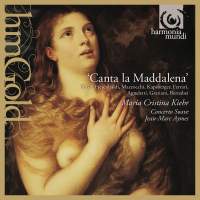Texte paru dans: / Appeared in: |
|
|
Outil de traduction |
|
|
Reviewer: Craig
Zeichner Italian composers of the 17th century put a new emphasis on the potency of the solo voice. As they stripped away contrapuntal artifice in an effort to fully realize the expressive powers of the vocalist, words and music never had a happier marriage. This stile moderno offered new melodic and harmonic possibilities for the composer. The Argentinean soprano Maria Cristina Kiehr has already recorded music by a host of 17th-century Italian composers, including discs devoted solely to Claudio Monteverdi, Giovanni Felice Sances, and Barbara Strozzi. With the exception of the Rome-born Sances (who worked mostly in Vienna), these recordings focused on the Venetian school. On this new recording, Canta la Maddalena, Kiehr sets her sights on a single region, Rome, and a specific subject, laments at the foot of the cross. The solo motet enjoyed a great boom in 17th-century Rome, where the seemingly incompatible monodie and bel canto styles were fused into a glorious whole. I'll go out on a limb and say that most of the music on this CD has probably not been recorded before. This recording presents such familiar names as Luigi Rossi and Girolamo Frescobaldi, alongside lesser-known composers such as Giovanni-Battista Agneletti (fl. 1656-73), Bonifato Gratiani (1604/5-64), and Ercole Bernabei (1622-87). Having opened myself up to possible abuse with that last statement, I should clarify that a few of these composers did not spend all of their lives in Rome. The most notable was Luigi Rossi, whose hair-raising Pender non prima vide is one of the outstanding moments of the recording. Rossi spent most of his time in Rome but did take two long trips to Paris. Indeed, his legendary opera Orfeo (six hours long!) was premiered at the instigation of Cardinal Mazarin in Paris in 1647. Rossi's lament, "Pender non prima vide," is influenced by the operatic style of the day. Highly dramatic, the lament was probably modeled after Monteverdi's Lamento d'Arianna, a piece that Rossi had copied out by hand. Rossi's lament is a stunner, with passionate recitative flowing into tender arioso. Kiehr must be a marvelous actress, because the intensity she brings to the work is mesmerizing; she empties her very soul into the lament. The extended recitativo displays a darker quality of her voice, which is ideal for Rossi's graphic depiction of the crucifixion. When Kiehr sings the arioso, her tenderness and careful phrasing soothe like balm on a wound. As you listen to more of this music you cannot escape the strong influence of the contemporary operatic style on the sacred music of the day. Domenico Mazzocchi (1592-1665), the favorite of Popes Urban VIII and Innocent X, is represented by three works. Mazzocchi's Lagrime Amare, taken from his Dialoghi e Sonetti, 1638, is another work that makes great dramatic demands of the singer. There are also some wicked harmonic shifts coursing through the work that Kiehr manages with ease. Mazzocchi's other solo motets, Dunque ove tu Signor and Homai le luci erranti, show how effectively operatic composers fused their dramatic and lyrical gifts to the sacred form. Perhaps the most wildly dramatic work on the recording is Ercole Bernabei's (1622-87) Heu me miseram et infelicem. Bernabei grew up in Rome and held important posts at a number of churches. In 1674, he was appointed Kapellmeister to Prince Ferdinand Maria of Bavaria, and he was charged to compose operas. Bernabei was apparently adept at both the stile antico and stile moderno, but make no mistake: The music on this recording is firmly in the modern style. Bernabei opens the work with a cry of misery, with dissonance and an almost hysterical sense of grief. Kiehr deserves lots of credit for selecting this motet. Its opening phrases surge with a burst of volume that compromises the tonal beauty of her voice. Kiehr bravely sacrifices beauty for drama, and the result is devastating: It's a Caravaggio painting in music. Concerto Soave, comprised of lute, harp, bass viol, and harpsichord or organ, provides continuo support that, at times, is a bit too stolid. I can't help but wonder what fire Rinaldo Alessandrini and Concerto Italiano would have brought to the music. Instrumental works by Frescobaldi, Michelangelo Rossi, and Giovanni Girolamo Kapsberger provide respite from the almost relentless intensity of the vocal works. Harpist Maria Galassi plays beautifully in Frescobaldi's Toccata per l'arpa, and harpsichordist Jean-Marc Aymes nimbly negotiates the tricky turns presented by Michelangelo Rossi's Toccata settima per clavicembalo. This is an excellent addition to the discography of this remarkably gifted singer. It also presents another side of the wonderfully rich world of 17th-century Italian song. Perhaps a future disc devoted to Bernabei, or Kiehr singing the music of the Neapolitan Francesco Provenzale (1624-1704), would make a good follow-up? | |
|
|
|
|
|
|
|
Cliquez l'un ou l'autre
bouton pour découvrir bien d'autres critiques de CD |
|




